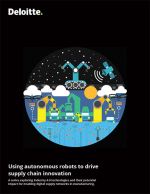The Rise of the Digital Supply Network
In this paper, we explore and analyze the next stage of growth for supply chains in an interconnected and open system digital supply network.
Supply chains traditionally are linear in nature, with a discrete progression of design, plan, source, make, and deliver.
Today, however, many supply chains are transforming from a staid sequence to a dynamic, interconnected system that can more readily incorporate ecosystem partners and evolve to a more optimal state over time.
This shift from linear, sequential supply chain operations to an interconnected, open system of supply operations could lay the foundation for how companies compete in the future.
We call this interconnected, open system a digital supply network (DSN).
DSNs integrate information from many different sources and locations to drive the physical act of production and distribution.
The result can be a virtual world, which mirrors and informs the physical world. By leveraging both the traditional and the new, such as sensor-based data sets (such as unstructured data), DSNs enable integrated views of the supply network and rapid use-case-appropriate latency responses to changing situations.
Historically, supply chain professionals managed the “four Vs” (volatility, volume, velocity, and visibility) as they attempted to optimize results across a series of objectives that include total cost, service, quality, and support for innovation. These traditional priorities are not likely to change, but going forward, supply chain decision-makers should be able to achieve higher levels of performance with supply chain capabilities developed with new digital technologies.
Change is often hard, but the digitization of information and the application of advanced innovative technologies present the opportunity to drive business value throughout the supply chain. Moreover, digital disruption can change supply chains in any industry. To avoid becoming a victim of disruption, it helps to understand these shifts and adapt accordingly.
In this paper, we explore and analyze the next stage of growth for supply chains in DSNs by:
- Tracing the technological evolutions that enable the rise of the DSN
- Defining what the DSN is, along with its role within a wider business strategy
- Examining the trade-offs inherent in a typical supply chain, and identifying the characteristics that can mitigate those trade-offs
- Considering how to build a DSN
What’s Related




Favorites





